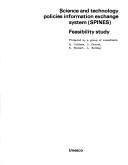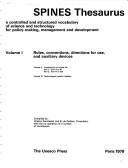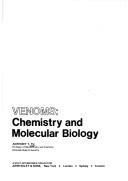| Listing 1 - 10 of 21 | << page >> |
Sort by
|
Book
Abstract | Keywords | Export | Availability | Bookmark
 Loading...
Loading...Choose an application
- Reference Manager
- EndNote
- RefWorks (Direct export to RefWorks)
ANA Anatomy & Morphology --- anatomy --- spines --- thorns
Article
Publisher: Bruxelles Marcel Hayez
Abstract | Keywords | Export | Availability | Bookmark
 Loading...
Loading...Choose an application
- Reference Manager
- EndNote
- RefWorks (Direct export to RefWorks)
ANA Anatomy & Morphology --- anatomy --- hooks --- spines --- thorns
Book
ISBN: 0323483917 0323400663 9780323483919 9780323400664 Year: 2018 Publisher: Philadelphia, PA
Abstract | Keywords | Export | Availability | Bookmark
 Loading...
Loading...Choose an application
- Reference Manager
- EndNote
- RefWorks (Direct export to RefWorks)
Spine --- Surgery. --- Spinal Diseases --- Orthopedic Procedures --- Surgery --- surgery. --- methods. --- Dendritic Spines --- Dendritic Spine --- Spine, Dendritic --- Spines, Dendritic
Book
Year: 1903 Publisher: Leipzig Gebrüder Borntraeger
Abstract | Keywords | Export | Availability | Bookmark
 Loading...
Loading...Choose an application
- Reference Manager
- EndNote
- RefWorks (Direct export to RefWorks)
ANA Anatomy & Morphology --- anatomy --- leaf --- meristem --- morphology --- sieve elements --- spines --- thorns --- tree architecture --- vascular tissue

Abstract | Keywords | Export | Availability | Bookmark
 Loading...
Loading...Choose an application
- Reference Manager
- EndNote
- RefWorks (Direct export to RefWorks)
Science --- Technology --- Science --- Technology --- SPINES (Information retrieval system). --- Information services. --- Information services. --- Documentation. --- Documentation.

ISBN: 9231013777 Year: 1976 Volume: vol 39 Publisher: Paris The Unesco Press
Abstract | Keywords | Export | Availability | Bookmark
 Loading...
Loading...Choose an application
- Reference Manager
- EndNote
- RefWorks (Direct export to RefWorks)
SPINES (Information retrieval system) --- Subject headings --- Science. --- Technology. --- SPINES (Information retrieval system). --- Vedettes-matière. Technologie / et Etat --- Onderwerpwoorden. Wetenschap / en Staat --- Vedettes-matière. Sciences / et Etat --- Onderwerpwoorden. Technologie / en Staat
Book
Abstract | Keywords | Export | Availability | Bookmark
 Loading...
Loading...Choose an application
- Reference Manager
- EndNote
- RefWorks (Direct export to RefWorks)
The amyloid precursor protein APP plays a key role in the pathogenesis of Alzheimer’s disease (AD), as proteolytical cleavage of APP gives rise to the Aß peptide which is deposited in the brains of Alzheimer patients. Despite this, our knowledge of the normal cell biological and physiological functions of APP and the closely related APLPs is limited. This may have hampered our understanding of AD, since evidence has accumulated that not only the production of the Aß peptide but also the loss of APP-mediated functions may contribute to AD pathogenesis. Thus, it appears timely and highly relevant to elucidate the functions of the APP gene family from the molecular level to their role in the intact organism, i.e. in the context of nervous system development, synapse formation and adult synapse function, as well as neural homeostasis and aging. Why is our understanding of the APP functions so limited? APP and the APLPs are multifunctional proteins that undergo complex proteolytical processing. They give rise to an almost bewildering array of different fragments that may each subserve specific functions. While Aß is aggregation prone and neurotoxic, the large secreted ectodomain APPsa - produced in the non-amyloidogenic a-secretase pathway - has been shown to be neurotrophic, neuroprotective and relevant for synaptic plasticity, learning and memory. Recently, novel APP cleavage pathways and enzymes have been discovered that have gained much attention not only with respect to AD but also regarding their role in normal brain physiology. In addition to the various cleavage products, there is also solid evidence that APP family proteins mediate important functions as transmembrane cell surface molecules, most notably in synaptic adhesion and cell surface signaling. Elucidating in more detail the molecular mechanisms underlying these divers functions thus calls for an interdisciplinary approach ranging from the structural level to the analysis in model organisms. Thus, in this research topic of Frontiers we compile reviews and original studies, covering our current knowledge of the physiological functions of this intriguing and medically important protein family.
Amyloid precursor-like protein --- learning and memory --- neuroprotection --- spines --- synaptic plasticity --- Alzheimers disease --- animal model --- synaptogenesis --- synaptic adhesion --- Amyloid precursor protein
Book
Abstract | Keywords | Export | Availability | Bookmark
 Loading...
Loading...Choose an application
- Reference Manager
- EndNote
- RefWorks (Direct export to RefWorks)
The amyloid precursor protein APP plays a key role in the pathogenesis of Alzheimer’s disease (AD), as proteolytical cleavage of APP gives rise to the Aß peptide which is deposited in the brains of Alzheimer patients. Despite this, our knowledge of the normal cell biological and physiological functions of APP and the closely related APLPs is limited. This may have hampered our understanding of AD, since evidence has accumulated that not only the production of the Aß peptide but also the loss of APP-mediated functions may contribute to AD pathogenesis. Thus, it appears timely and highly relevant to elucidate the functions of the APP gene family from the molecular level to their role in the intact organism, i.e. in the context of nervous system development, synapse formation and adult synapse function, as well as neural homeostasis and aging. Why is our understanding of the APP functions so limited? APP and the APLPs are multifunctional proteins that undergo complex proteolytical processing. They give rise to an almost bewildering array of different fragments that may each subserve specific functions. While Aß is aggregation prone and neurotoxic, the large secreted ectodomain APPsa - produced in the non-amyloidogenic a-secretase pathway - has been shown to be neurotrophic, neuroprotective and relevant for synaptic plasticity, learning and memory. Recently, novel APP cleavage pathways and enzymes have been discovered that have gained much attention not only with respect to AD but also regarding their role in normal brain physiology. In addition to the various cleavage products, there is also solid evidence that APP family proteins mediate important functions as transmembrane cell surface molecules, most notably in synaptic adhesion and cell surface signaling. Elucidating in more detail the molecular mechanisms underlying these divers functions thus calls for an interdisciplinary approach ranging from the structural level to the analysis in model organisms. Thus, in this research topic of Frontiers we compile reviews and original studies, covering our current knowledge of the physiological functions of this intriguing and medically important protein family.
Amyloid precursor-like protein --- learning and memory --- neuroprotection --- spines --- synaptic plasticity --- Alzheimers disease --- animal model --- synaptogenesis --- synaptic adhesion --- Amyloid precursor protein

ISBN: 0471892297 Year: 1977 Publisher: London : John Wiley,
Abstract | Keywords | Export | Availability | Bookmark
 Loading...
Loading...Choose an application
- Reference Manager
- EndNote
- RefWorks (Direct export to RefWorks)
Insects. Springtails --- Animal biochemistry --- Molecular biology --- Reptiles --- Toxicology --- 591.572.5 --- Stinging capsules. Poisonous spines. Irritant hairs. Poisonous juice. Venom. Repellent fluids. Sepia --- 591.572.5 Stinging capsules. Poisonous spines. Irritant hairs. Poisonous juice. Venom. Repellent fluids. Sepia --- Hydrolases --- Poisonous snakes --- Venom --- Venoms --- Antivenins --- Poisonous animals --- Toxins --- Venomous snakes --- Vipers --- Snakes --- Hydrolytic enzymes --- Enzymes --- Physiological effect
Book
ISSN: 05481198 ISBN: 9060161343 Year: 1980 Volume: vol 134 Publisher: Amsterdam Wetenschappelijke uitg.
Abstract | Keywords | Export | Availability | Bookmark
 Loading...
Loading...Choose an application
- Reference Manager
- EndNote
- RefWorks (Direct export to RefWorks)
Pathology of the organs of movement --- Neuropathology --- spina bifida --- Paediatrics --- Neurologie --- Spinal Dysraphism. --- Cleft Spine --- Open Spine --- Schistorrhachis --- Spinal Dysraphia --- Rachischisis --- Spina Bifida --- Status Dysraphicus --- Bifida, Spina --- Dysraphia, Spinal --- Dysraphias, Spinal --- Dysraphicus, Status --- Dysraphism, Spinal --- Dysraphisms, Spinal --- Rachischises --- Spina Bifidas --- Spinal Dysraphias --- Spinal Dysraphisms --- Cleft Spines --- Open Spines --- Spine, Cleft --- Spine, Open --- Spinal Dysraphism
| Listing 1 - 10 of 21 | << page >> |
Sort by
|

 Search
Search Feedback
Feedback About UniCat
About UniCat  Help
Help News
News